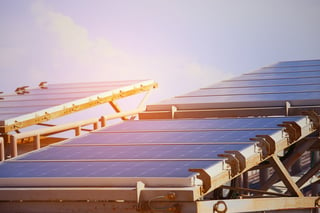 We’ve all seen them and heard about the great value solar panels can bring. As time goes on, the cost to install solar energy has decreased and their usage has increased. With growth averaging 60% annually since 2007, a new solar project is installed every 2.5 minutes. As of 2014, nearly 645,000 U.S. homes and businesses have gone solar. Is solar energy right for you? The Department of Energy provides very useful information to help you decide.
We’ve all seen them and heard about the great value solar panels can bring. As time goes on, the cost to install solar energy has decreased and their usage has increased. With growth averaging 60% annually since 2007, a new solar project is installed every 2.5 minutes. As of 2014, nearly 645,000 U.S. homes and businesses have gone solar. Is solar energy right for you? The Department of Energy provides very useful information to help you decide.
Before installing solar panels on your home or business, there are some loss control and safety items to consider. Here are a few. Click here to read the full list – Solar Panel Safety Summary.
Spacing requirements
- All buildings with rooftop solar panels are required to have a four-foot wide, clear-walking perimeter around all edges of the roof. This allows fire fighters to access the roof at any area of the building. On buildings with a roof larger than 250’ x 250’, a 6-foot wide clear-walking perimeter is required.
- Four-foot wide pathways are required to extend from the perimeter access area to any skylights, ventilation hatches, roof standpipes, and roof access hatch.
Weight restrictions/structural support
- Typical solar panels weigh 20 to 50 pounds each and are distributed and attached evenly across roof-racking systems. The racking system fastens them to the roof at a desired angle and prevents water and debris from penetrating the roof.
- Consider the weight of solar panels. Make certain your structure is designed to support them. Also take into consideration the added weight of snow and ice. Roofs need to be inspected by an engineer before installation to ensure strength is adequate to support the load.
Maintenance
- Panels should be inspected a few times a year for debris or dirt build up and any damage to the panels. Debris collection may also affect roof drainage and/or create drainage issues. A prevent maintenance plan should be put in place for debris management.
- An electrician should inspect wiring connections and terminations annually for corrosion and tightness, and repair or replace as needed.
Fire Protection
- The facility should have a site plan that shows the location of major components on the property, including solar array layout, location of access pathways for the rooftop system for fire department review, and the location of the utility disconnect.
- Detailed electrical diagrams showing and specifying all major components used in the electrical portion of the solar system are needed. They must show the configuration of the solar array, location and rating of overcurrent protection and disconnecting means, callout conduit, and wire size, type, and rating.
- In the event of a fire, first responders will cut the power to the building before attempting to fight the fire. Solar panels are designed to generate electricity if there’s any light present; this is also true in low-light settings. There may be a delayed response from a fire department when a building has solar panels, especially if the fire department isn’t confident the power is cut. Pre-planning with your fire department is extremely important so the responding department fully understands your system.




